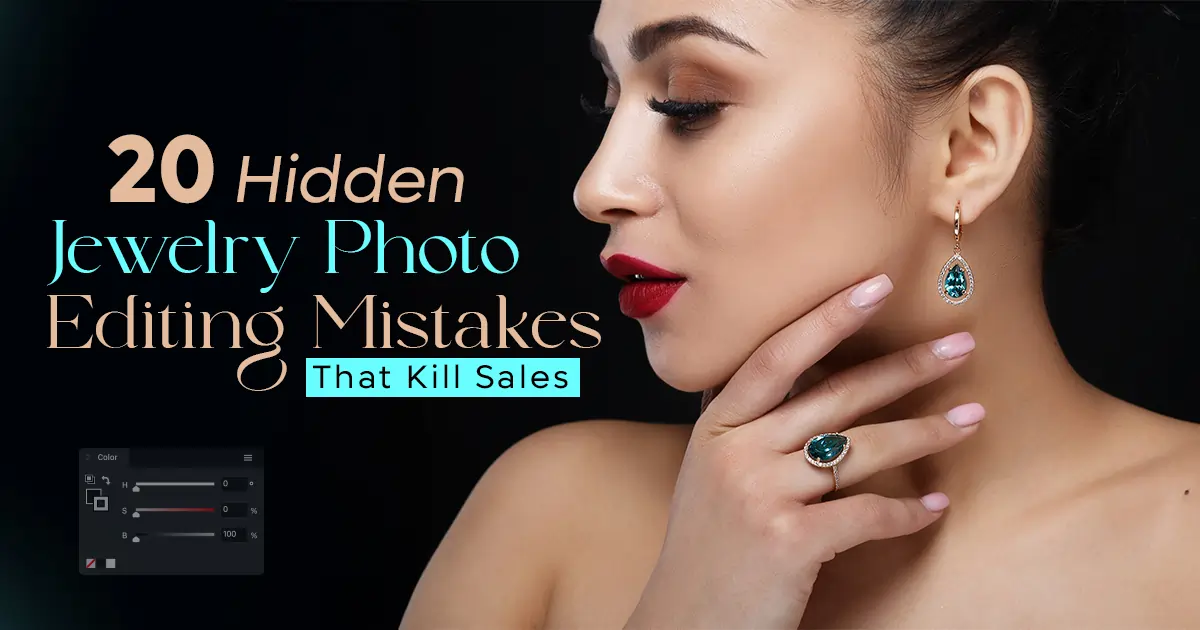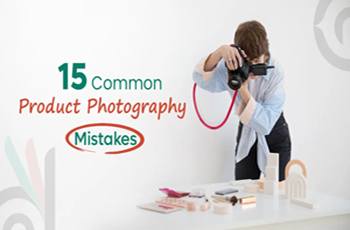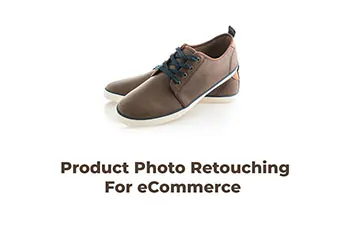20 Hidden Jewelry Photo Editing Mistakes That Kill Sales
Most jewelry image editing mistakes are invisible at first glance, but your customers notice them subconsciously. Maybe the gold looks plasticky, the diamonds seem dull.
These subtle problems trigger doubt, and doubt kills sales faster than high prices ever could. Here are the top 20 jewelry retouching errors that might stop sales:
These are totally fixable. Scroll a bit to learn the fixes as well. If you can’t do it by yourself, hire an affordable jewelry retouching service to do it on your behalf.
Relatable Reads: Best 5 Photo Retouching Providers to Choose From Free Trial
Where Most Brands Go Wrong With Jewelry Photos?
Many brands unknowingly repeat the same jewelry image editing mistakes that quietly kill sales. So, where do they go wrong?
They focus on filters, not realism.
They brighten everything but lose the natural shine and depth.
They ignore metal tone consistency across images.
They overuse blur and smoothing tools, making textures look plastic.
These common jewelry retouching errors make luxury pieces look cheap or artificial. The photo quality went down the drain. Customers can and will zoom in on every sparkle; even minor photo retouching errors can destroy trust.
What Makes a Jewelry Image Look “Edited” Instead of “Expensive”?
The subtle differences between enhancing and over-retouching. When you cross that line, even the most beautiful ring looks fake.
Enhancing means refining what’s already there. It can be fixing lighting, removing dust, and improving clarity.
Over-retouching means editing something that doesn’t exist. Those are removing reflections, changing metal tone, or making gems glow unnaturally.
To understand the difference, ask yourself:
Does the diamond still reflect natural light patterns?
Does the gold still have its warm tone?
Are shadows and highlights balanced or completely wiped out?
Why Realistic Shine and True Metal Tone Matter?
Here is the reason:
Gold should look like gold, not yellow paint.
Silver needs reflection, not flat gray tones.
Gemstones need sparkle, not glowing neon color.
These subtle differences are what separate luxury jewelry photos from amateur edits. Shoppers buy with their eyes first, and if your images feel “off,” they’ll scroll away.
Check out: Necklace Photo Retouching
20 Hidden Jewelry Photo Editing Mistakes That Kill Sales
Jewelry photos can seriously lower your sales. A lot of times, bad images mess things up. Buyers can spot poor editing, even if they can’t say what’s off about it.
Let’s show you the top 20 jewelry retouching errors that could be costing you sales and how to fix them.
Over-smoothing Metal Surfaces
When gold or silver gets the blur tool treatment, it loses its natural texture. Real metal has subtle variations and grain that give it character.
Why does it happen:
Trying to hide imperfections too aggressively
Using automated smoothing tools without checking results
Not understanding metal properties
The fix: Professional jewelry photo retouching services are known to preserve metal texture while cleaning up only actual flaws.
Wrong Reflection Angles
Reflections tell our brains about shape and depth. Get the angles wrong, and the piece looks distorted or fake.
What goes wrong:
Adding reflections that don't match the lighting setup
Copy-pasting reflections without adjusting perspective
Ignoring the original light source direction
The fix: Match your edited reflections to the actual lighting in your shot. When buyers zoom in, everything should make visual sense.
Unnatural Gemstone Shine
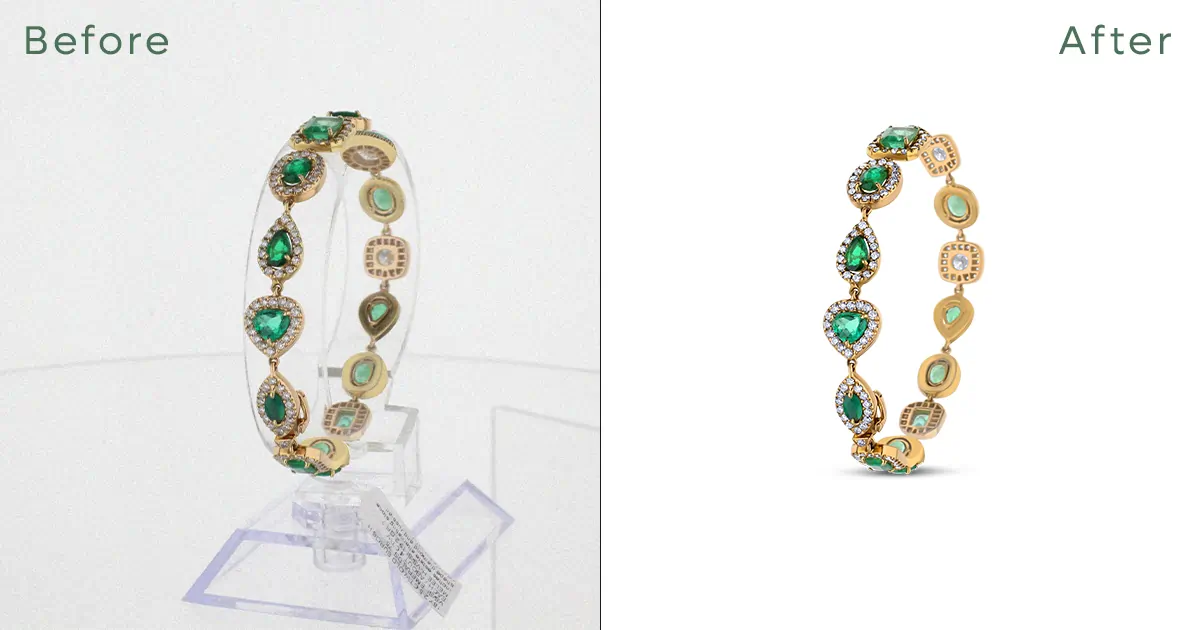
There's sparkle, and then there's "alien laser beam." Over-brightening gemstones creates glare instead of that desirable natural fire.
Common mistakes:
Cranking up highlights too far
Adding fake shine that doesn't follow facet patterns
Ignoring jewelry photo color correction issues
The fix: Your editing should enhance existing sparkle points, not create new ones from thin air.
4. Inconsistent White Balance
When gold looks different in your product catalog, it really reflects how skilled your editors are. You can see it in every frame and page.
Why consistency matters:
Customers compare pieces side-by-side
Mismatched tones damage brand trust
Returns increase when color expectations aren't met
The Fix: Set a standard white balance profile for all your jewelry product photography editing. Use the same reference point for every shoot.
5. Excessive Contrast
Cranking contrast adds drama, but it hides the fine craftsmanship that makes jewelry special.
What gets lost:
Delicate engravings disappear into shadows
Filigree work becomes unreadable
Metal grain turns into muddy patches
The Fix: One of the best practices for jewelry photo retouching is using subtle contrast adjustments. Giving definition without destroying detail.
6. Dust or Fingerprints Left Unremoved
Smudges instantly kill luxury perception. This is one of the easiest jewelry image editing mistakes to avoid, yet it's surprisingly common.
The Fix:
Always inspect at 100% zoom before delivering
Check prongs, settings, and flat surfaces
Don't rely on "it's small enough to ignore"
7. Missing Shadow or Wrong Drop Shadow
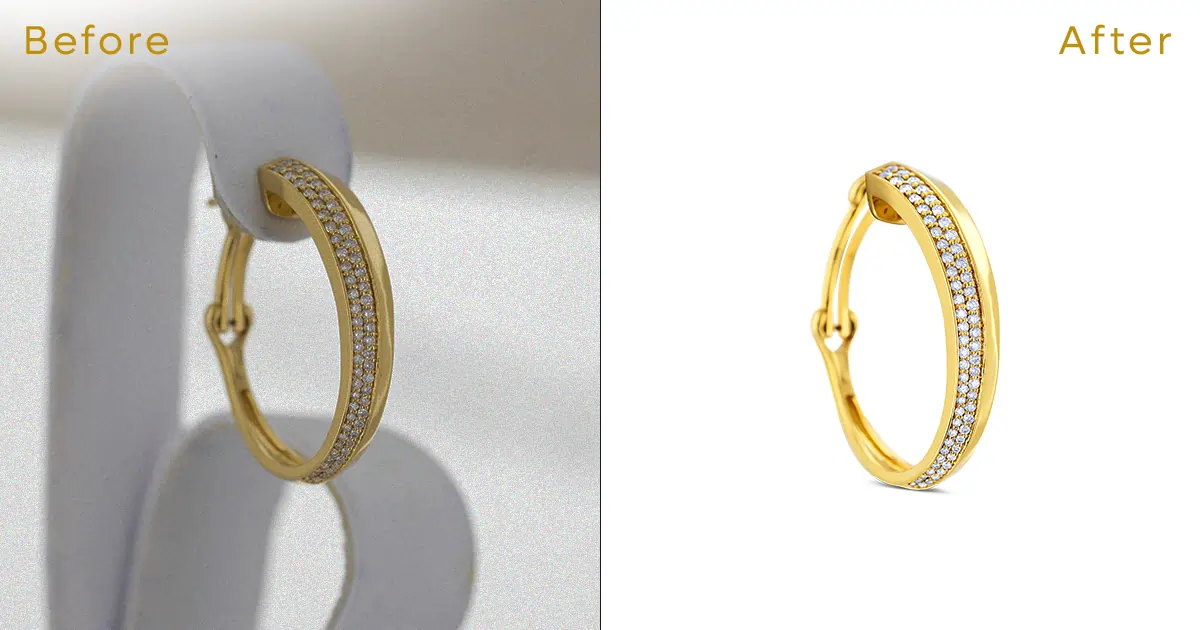
Floating jewelry looks weird. Products need proper grounding. A shadow makes physical sense.
Shadow mistakes to avoid:
Generic drop shadows that look pasted on
Shadows are going the wrong direction from the light source
Missing shadows entirely (creates that floating effect)
The fix: Soft shadows for diffused light, harder shadows for direct light. Your jewelry product image retouching guide should include shadow reference photos.
8. Color Cast from Studio Lights
Studio lights can add unwanted color tints like yellow, blue, or green. This makes gold tones look completely wrong.
Common scenarios:
LED lights add cool blue tints
Tungsten creates orange-yellow casts
Mixed lighting sources fight each other
The fix: Professional jewelry editing tips always include checking for color casts in neutral areas first. Fix the cast globally before adjusting individual metal tones.
9. Incorrect Color Correction for Gemstones
A sapphire that looks purple or an emerald that's too yellow? These common jewelry retouching errors directly impact purchase decisions.
Why accuracy matters:
Gemstone color determines value
Wrong colors bring returns and complaints
Brand credibility suffers
The fix: Compare to physical samples. Jewelry photo retouching services have the proper color management tools.
10. Overexposed Diamonds
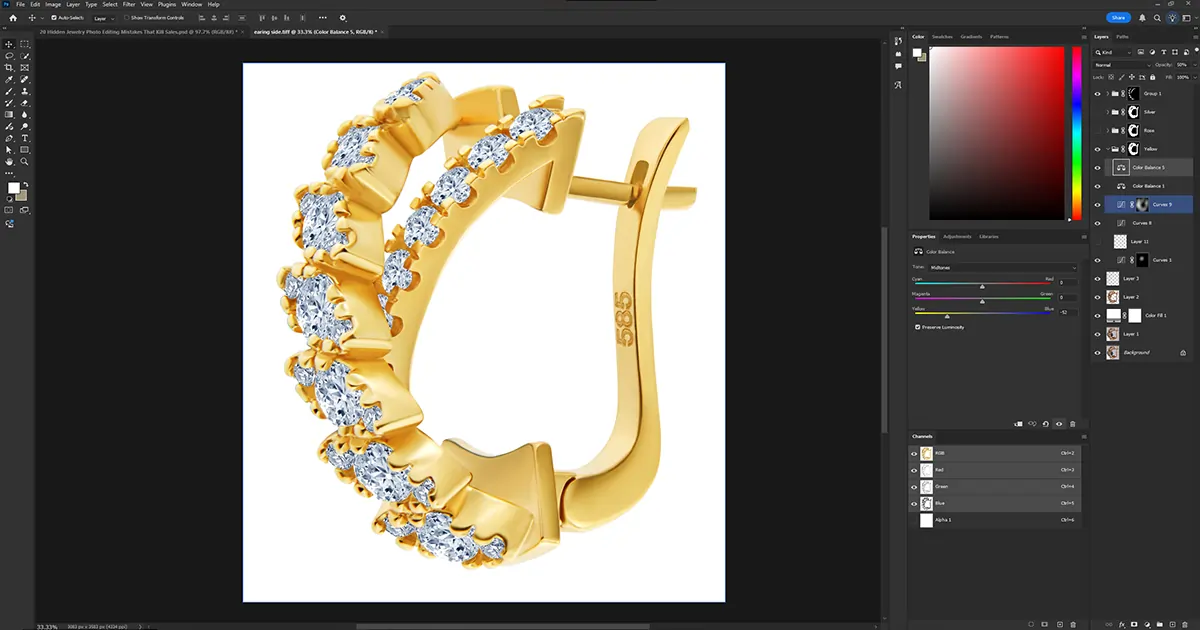
Blasting highlights on diamonds makes them look like white blobs.
What disappears:
Individual facet definition
Clarity characteristics
The fire and brilliance that make diamonds valuable
The fix: Preserve those bright sparkle points while keeping enough mid-tones to show facet structure. This is jewelry photo quality improvement done right.
11. Misaligned Symmetry
Perfectly symmetrical piece looks crooked in photos. It removes the luxury perception. This is a subtle but deadly jewelry photography retouching mistake.
Alignment issues:
Earrings that don't match
Pendants hanging at odd angles
Rings photographed at tilted angles
The fix: Use guides and alignment tools. For pairs, ensure they mirror perfectly. High-end jewelry demands precise presentation.
12. Reflection of Camera/Retoucher in Metal
Few things are more embarrassing than zooming in and seeing the photographer.
Where reflections hide:
Highly polished bezels
Large flat metal surfaces
Curved areas that act like mirrors
The fix: Always check reflective surfaces at high magnification. Clone out or carefully reconstruct these areas to maintain that seamless, professional look.
13. Background Mismatch
One product on pure white, another on cream, another on gray? Inconsistent backgrounds destroy visual branding.
Problems this creates:
Unprofessional catalog appearance
Harder for customers to compare pieces
Weakens brand identity
The fix: Pick one background style and stick with it across all jewelry product image retouching work.
14. Jagged Edges from Bad Clipping Paths
Nothing says "amateur" like stair-stepped edges when customers zoom in.
Clipping path mistakes:
Using a magic wand instead of the pen tool
Not zooming in while creating paths
Forgetting to smooth anchor points
The fix: Smooth, precise clipping paths look infinitely better. This is a basic jewelry product photography editing move. You're losing sales if your edges look like Lego blocks up close.
15. Unretouched Prongs or Settings
Scratched, dinged, or tarnished prongs draw the eye away from beautiful gemstones.
What to clean up:
Minor scratches on prongs
Oxidation in crevices
Manufacturing marks on settings
The fix: Clean up distracting flaws while keeping the realistic metal texture. This is where best practices for jewelry photo retouching shine literally.
16. Poor Focus Stacking
When parts of your jewelry are sharp and other parts are mysteriously blurry, buyers get confused and concerned.
Focus stacking fails:
Halos around merged areas
Inconsistent sharpness across the piece
Soft spots that look like defects
The fix: Proper focus stacking involves taking multiple shots at different focus points and seamlessly blending them. This technique is essential for improving jewelry photo quality.
17. Ignoring Micro-scratches
Tiny scratches that seem invisible become glaringly obvious on 4K monitors and retina displays.
Why they matter:
Suggest the piece is used or damaged
Lower perceived value
Create return requests
The fix: Part of why jewelry photos look unrealistic is over-correction. Carefully remove distracting scratches while keeping the natural metal texture.
18. Oversized Watermark
Slapping a huge watermark across luxury jewelry is like putting a bumper sticker on a Mercedes. It kills the premium feel instantly.
Watermark problems:
Covers important product details
Looks defensive and unprofessional
Distracts from the jewelry itself
The fix: Use subtle, corner-placed watermarks or embed metadata. Your jewelry photo editing for eCommerce should protect your work without destroying the presentation.
19. Missing Natural Highlight Balance
Real jewelry sparkles in specific ways based on its cut, setting, and polish. Flatten those highlights, and you flatten buyer interest.
Highlight mistakes:
Reducing all bright spots equally
Not understanding how different metals reflect light
Over-editing jewelry product images until they look dull
The fix: Study jewelry photo editing before and after examples from pros. Notice how they preserve sparkle while controlling exposure.
20. File Exported in Wrong Color Profile
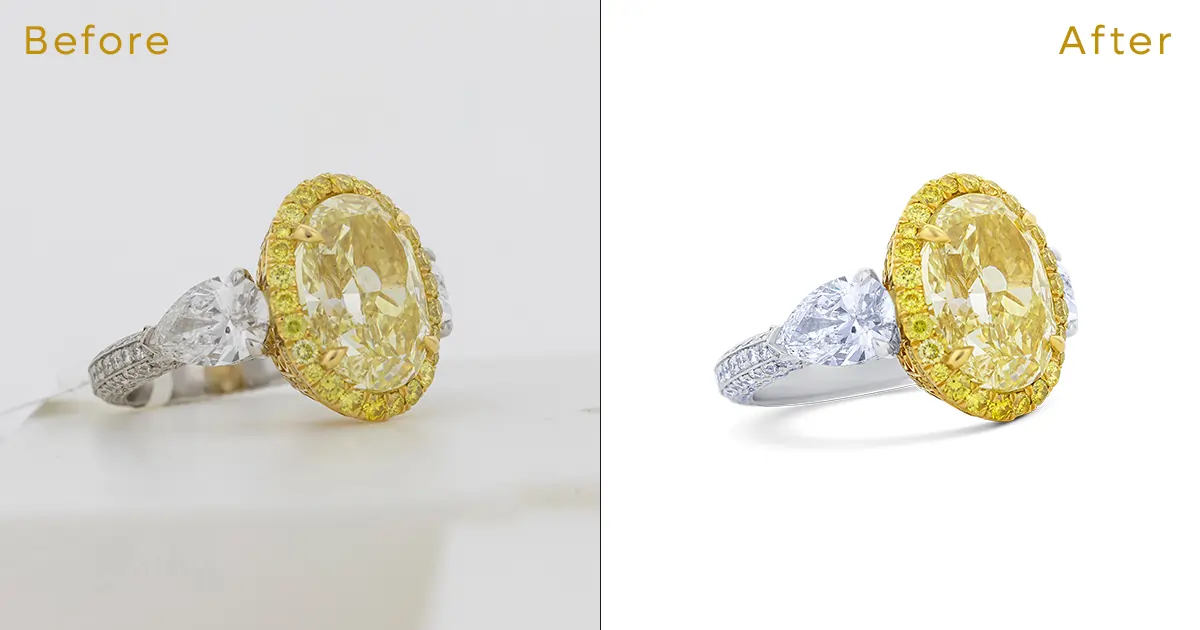
Here's a technical gotcha: export your web images in CMYK instead of RGB, and they'll look dull and sad on every screen.
Profile problems:
RGB for web and screens
CMYK for print materials
sRGB specifically for most eCommerce platforms
The fix: Part of professional jewelry editing tips is maintaining separate export presets for different uses. Check those export settings every single time.
Also Reads: 20 Best Background Ideas for Jewelry Photography in 2025
Why Do These Editing Errors Go Unnoticed?
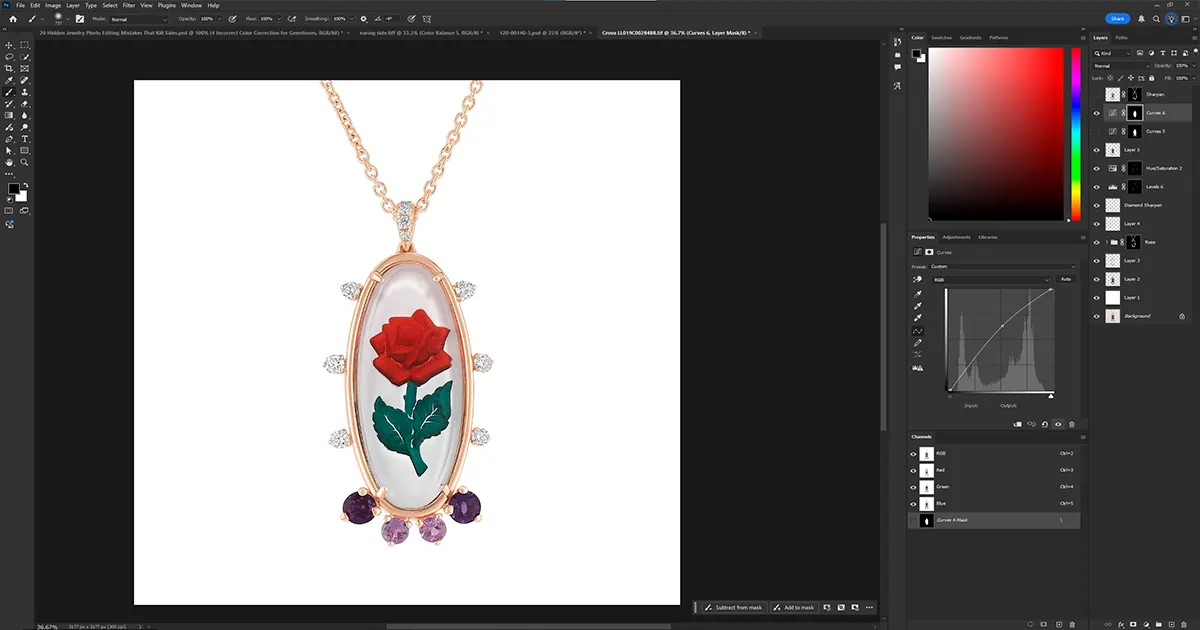
There are a couple of reasons it happens. Here is our take on why these errors slip through and how to catch them before they hurt your sales.
Fast Editing Pipelines Overlook Luxury Detailing
Tiny details get sacrificed when you rush through 50 product images a day. Speed and quality rarely play nice together.
What gets missed in the rush:
Micro-scratches on prongs
Subtle color casts that need careful correction
Reflections hiding in curved metal surfaces
Asymmetry issues in paired jewelry
This is where over-editing jewelry product images happens. You lose the unique characteristics that make each jewelry piece special.
Editors Without Jewelry Expertise
Understanding metals and gemstones changes everything. These differences can only be seen through expert jewelry retochers.
Knowledge gaps that hurt quality:
Not knowing how different gold karats reflect light differently
Misunderstanding how gemstone facets create sparkle patterns
Treating all shiny surfaces the same way
Missing the difference between polishing and over-smoothing
This is huge for jewelry photo color correction issues. Each gemstone has acceptable color ranges; messing with them creates return nightmares.
Clients Assume Photo Quality Equals Edit Quality
This might be the biggest misconception in jewelry product photography editing. A sharp photo isn't automatically a well-edited photo.
The confusion explained:
Great photography captures good raw material
Great editing enhances and corrects that material
One doesn't guarantee the other
Clients often can't articulate what's wrong without seeing jewelry photo editing before and after comparisons side-by-side.
Check out: Best Tips to Get Eye-Catchy Images For Social Media
What Should You Look for in Professional Jewelry Retouching Services?

Choosing the right jewelry photo retouching services can make or break your online sales. Not all retouching companies understand your unique demands for luxury jewelry.
Those jewelry image editing mistakes we talked about? They often come from picking the wrong editing partner. Here is how you can find the best photo retouching company.
Detail-Oriented Editors with Jewelry Background
Generic photo editors and jewelry specialists are worlds apart.
Why jewelry expertise matters:
Understanding metal properties and how they photograph
Knowing gemstone characteristics and color ranges
Recognizing quality craftsmanship details worth highlighting
Avoiding common jewelry retouching errors that general editors make
This expertise directly addresses why jewelry photos look unrealistic when handled by non-specialists.
Proof-Based QC Process, Not Automated Bulk Edits
You need human eyes to check every detail at high magnification.
What quality control should include:
Multiple review stages before delivery
Checking images at 100%+ zoom levels
Consistency checks across product collections
Color accuracy verification against standards
Top-tier jewelry product image retouching services show you detailed before-and-after comparisons. They walk you through their edits.
Transparent Communication & Before-After Approval Process
Poor communication kills projects faster than poor editing skills.
Communication essentials:
Clear turnaround time expectations
Defined revision policies
Easy-to-understand pricing structure
Responsive support when you have questions
Quality jewelry photo retouching services include reasonable revisions in their packages. They don't make you feel bad for asking for adjustments.
Fast Turnaround with Consistent Tone Across Collections
Speed matters in eCommerce, but not at the expense of quality or consistency.
Turnaround expectations:
Simple edits (dust removal, basic color correction): 24-48 hours
Complex retouching (focus stacking, extensive cleanup): 2-4 days
Bulk collections: Clearly defined timelines based on volume
Rush options available when needed (with reasonable upcharges)
Smart jewelry product photography editing services consider collections rather than individual images.
Wrapping Up
Every jewelry image editing mistake you avoid is money saved and sales earned. So, don't let editing mistakes cost you another sale. Your jewelry deserves images as beautiful as the pieces themselves.
Visit Perfect Retouching to see real examples of jewelry transformation and learn how they can handle your specific needs.
 English
English
 Arabic
Arabic
 Danish
Danish
 Dutch
Dutch
 Finnish
Finnish
 French
French
 German
German
 Hebrew
Hebrew
 Italian
Italian
 Japanese
Japanese
 Norwegian
Norwegian
 Polish
Polish
 Portuguese
Portuguese
 Spanish
Spanish
 Swedish
Swedish
 Russian
Russian

